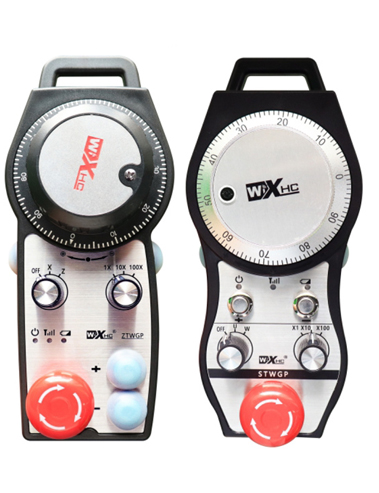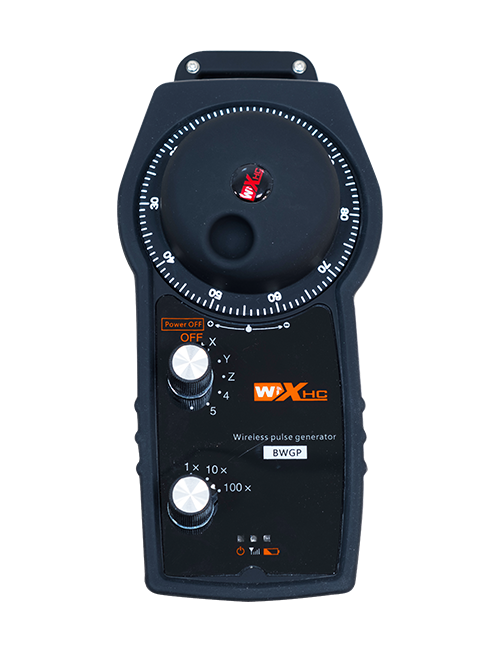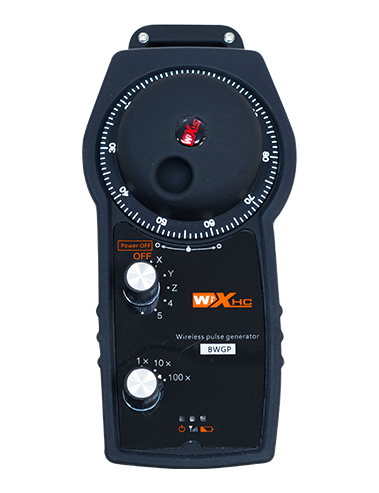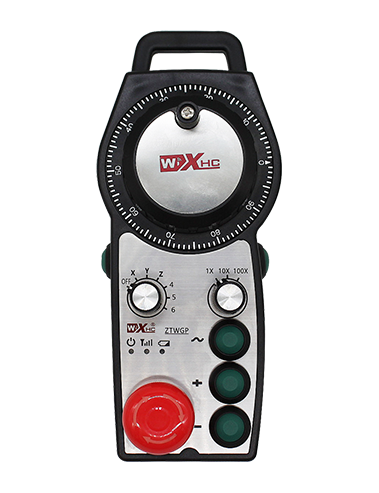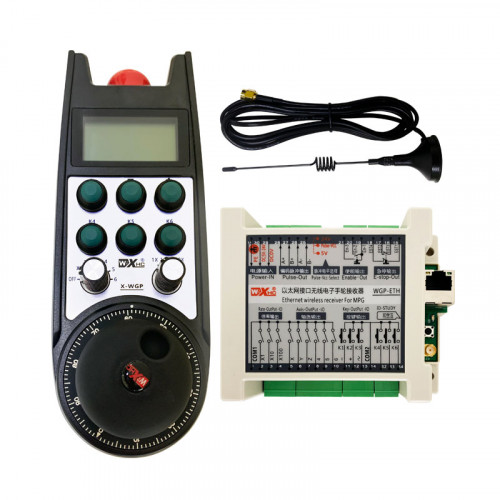Mamao Ahokore mo te Ahokore mo nga Taha Poari CNC
Whakaaturanga

1.Kupu whakataki
2. Product functional features
| Operating voltage and current of wireless remote |
3V/14MA
|
| Battery specifications | 2 AA alkaline batteries, size 5 |
| Low voltage alarm range of wireless remote | < 2.3K |
| Receiver power supply voltage | DC5V-24V/A |
| Receiver emergency stop output load range | AC125V-1A/DC30V-2A |
| Receiver enable output load range |
AC125V-1A/DC30V-2A
|
| Receiver custom button output load range | DC24V/50mA |
| Receiver axis selection output load range | DC24V/50mA |
| Receiver magnification output load range | DC24V/50mA |
| Transmission power of handheld terminal |
15dBm
|
| Receiver receiving sensitivity | -100dBm |
| Wireless communication frequency | 433MHz frequency band |
| Wireless communication distance | Barrier free distance of 40 mita |
| Operation temperature | -25℃ < Whakaahua x < 55℃ |
| Anti fall height | 1 (mīta) |
| Custom button quantity | 2 |


Pukapuka:
① Pulse encoder:
Press and hold the enable button, shake the pulse encoder, emit a pulse signal,and control the movement ofthe machine axis.
② Enable button:
Press either enable button on either side, and the two sets of enable IO outputs on the receiver will conduct. Release the enable button to disconnect the enable IO output; And before switching the axis selection magnification and shaking the handwheel,the enable button needs to be held down to be effective; This function can be cancelled through configuration software.
③ Indicator lights:
Left side light: power on light,the handwheel uses the axis to select OFF for power on, and this light stays on after power on;
Middle light: a signal light that lights up when operating any function ofthe handwheel, and does not light up when there is no operation;
Right side light: He iti te marama whakaohooho, low battery level,this lightflashes or stays on, battery needs to be replaced.
④ Emergency stop button:
Pēhi i te pātene aukati ohorere, and the two sets of emergency stop IO outputs on the receiver will be disconnected, and all functions of the handwheel will be invalid.
⑤ Magnification switch:
Press and hold the enable button to switch the magnification switch, which can switch the magnification controlled by the handwheel.
⑥ Axis selection switch (power switch):
Press and hold the enable button to switch the axis selection switch, which can switch the movement axis controlled by the handwheel. Switch this switch from OFF to any axis and turn on the handwheel power.
⑦ Custom button:
Two custom buttons, each corresponding to an IO output point on the receiver.

6.1 Product installation steps
1. Install the receiver into the electrical cabinet through the buckle on the back, or install it into the cabinet through the screw holes at the four corners of the receiver.
2. Refer to our receiver wiring diagram and compare it with your on-site equipment. Connect the equipment to the receiver via cables.
3.After the receiver is properly fixed, Ko te antena e rite ana ki te kaiwhiwhi me hono, and the outer end of the antenna should be installed or placed outside the electrical cabinet. E taunaki ana kia whakatakotoria ki runga i te tihi o te rūnanga hiko mo te paanga tohu pai. It is prohibited to leave the antenna unconnected or place it inside the electrical cabinet, as this may result in the signal being unusable.
4. Rawa, turn on the power switch of the handwheel, and you can operate the machine remotely using the handwheel.
6.2 Nga Taumata Whakauru

6.3 He hoahoa tohutoro a te kaiwhiwhi

7. Tohutohu Mahi Hua
1. Power on the machine and the receiver. The receiver’s working indicator light flashes. Install the battery in the wireless electronic handwheel, secure the battery cover, and
turn on the power switch of the wireless electronic handwheel. The handwheel’s battery level indicator light is on.
2. Select the coordinate axis: Press and hold the enable button, toggle the axis selection switch, and select the axis you want to operate.
3. Select magnification: Press and hold the enable button, toggle the magnification switch,and select the desired magnification level.
4. Moving axis: Press and hold the enable button, select the axis selection switch, select the magnification switch, and then rotate the pulse encoder. Rotate clockwise to move the
positive axis and counterclockwise to move the negative axis.
5. Press and hold any custom button, and the corresponding button IO output of the receiver will be turned on. Release the button, and the output will be turned off.
6. Pēhi i te pātene aukati ohorere, the corresponding emergency stop IO output of the receiver will be disconnected, the handwheel function will be disabled,release the emergency stop button, the emergency stop IO output will be closed, and the handwheel function will be restored.
7. If the handwheel is not operated for a period of time, it will automatically enter sleep mode to reduce power consumption. When it is used again, the handwheel can be activated by pressing the enable button.
8. If the handwheel is not used for a long time, it is recommended to switch the handwheel shaft to the OFF position, turn off the handwheel power, and extend the battery life.
8. Product Model Description

① :ZTWGP represents the appearance style
②:Pulse output parameters:
01: Indicates that the pulse output signal is A, B; Pulse voltage 5V; pulse quantity 100PPR.
02:Indicating thatthe pulse output signals are A and B; Pulse voltage 12V; pulse quantity 100PPR.
03:Indicating thatthe pulse output signals are A, B, A -, B -; Pulse voltage 5V; pulse quantity 100PPR.
04:Indicates a low-level NPN open circuit output, with pulse output signals of A and B;The number of pulses is 100PPR.
05:Indicates high-level PNP source output, with pulse output signals of A and B; The number of pulses is 100PPR.
③:Representing the number of axis selection switches, 2 represents 2 axes.
④:Represents the type of axis selection switch signal, A represents point-to-point output signal, and B represents encoded output signal.
⑤:Represents the type of multiplication switch signal, A represents point-to-point output signal, and B represents encoded output signal.
⑥:Represents the number of custom buttons, 2 represents 2 pātene ritenga.
⑦:Represents the power supply for the system handwheel, and 05 represents 5V power supply.
⑧:L represents the left column (left knife holder), and R represents the right column (right knife holder).
9.Solution to Product Malfunctions

1. Whakamahia koa ki te taiao maroke i te pāmahana o te rūma me te pehanga kia whakawhānuitia tana mahi ratonga.
2. Tena ra, kaua e whakamahia te whakamahi i nga taiao kore penei i te ua me nga mirumiru wai hei whakawhānui i te koiora ratonga.
3. Please keep the appearance of the handwheel clean to extend its service life.
4. Tena koa karohia te kotiti, hinga, tōpito, take. to prevent damage to the precision components inside the handwheel or accuracy errors.
5. Mena kaore i whakamahia mo te wa roa, Tena koa rongoa te ringaringa i te waahi ma me te haumaru. I te rokiroki me te waka, Me utu te aro ki te makuku me te aukati i te aukati.
11. Nga korero mo te Haumaru
1. Tena panuihia nga tohutohu i mua i te whakamahi me te aukati i nga umanga kore ngaio mai i te mahi.
2. Please replace the battery in a timely manner when the battery level is too low to avoid errors caused by insufficient battery power and inability to operate the handwheel.
3. Mena e hiahiatia ana te whakatikatika, Tena whakapā atu ki te kaiwhakanao. Mena he kino te kino na te whakatikatika i a ia ano, Kaore te kaiwhakanao e tuku raihana
